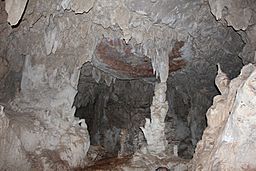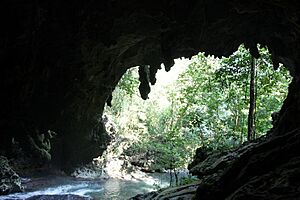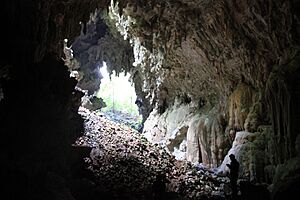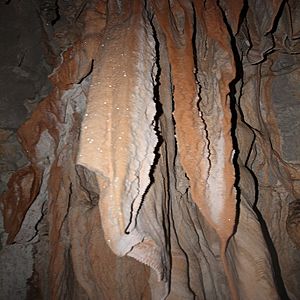Candelaria Caves facts for kids
Quick facts for kids Candelaria Caves |
|
|---|---|

|
|
| Location | Chisec, Raxruha (Guatemala) |
| Length | c. 80,000 metres (260,000 ft) |
| Discovery | Local Maya people |
| Geology | Karst |
| Entrances | multiple |
The Candelaria Caves are an amazing natural cave system in Guatemala. You can find them in the Alta Verapaz region, between the towns of Chisec and Raxruha. These caves are super famous for their unique rock formations and their important connection to the ancient Maya people.
Contents
Exploring the Caves
The Candelaria Caves are known for their huge underground spaces. Inside, you'll see incredible rock formations called speleothems. These include stalactites hanging from the ceiling and stalagmites growing from the floor. When they meet, they form tall stalagnates, like columns. You can also spot beautiful flowstone drapes, which look like frozen waterfalls.
How the Caves Formed
The caves are part of a special type of landscape called karst. This happens when soft rocks like limestone are slowly dissolved by water. Over thousands of years, this process creates amazing caves and underground rivers.
The Underground River
One of the most exciting parts of the Candelaria Caves is the underground river. The main cave tunnel is about 22 kilometers (13.7 miles) long. A big part of this, about 12.5 kilometers (7.8 miles), follows the Candelaria River as it flows deep beneath the ground. The entire cave system, including all its side passages and upper levels, is thought to be around 80 kilometers (50 miles) long!
Natural Skylights
Sometimes, parts of the cave ceiling collapse. This creates openings called pit caves. These pits act like natural skylights, letting sunlight stream into the dark caverns. It's a truly magical sight!
A Glimpse into History
The Candelaria Caves have a very rich history, especially with the Maya people.
Ancient Trade Routes
Long ago, during the Classic period of the Maya, these caves were part of an important trade route. This route connected the highlands of Guatemala to the lowlands of Petén. It was a busy path for trading goods and ideas.
Sacred Places
Archaeologists have found many pottery pieces and ancient rock paintings inside the caves. These findings show that the Maya used the caves for special ceremonies. The Maya believed that the Candelaria Caves were an entrance to Xibalba, their underworld.
Modern Maya Traditions
Even today, some of the caves are still used for traditional Maya celebrations. It's a way for the local Q'eqchi' people to connect with their ancestors and keep their culture alive. While these ceremonies continue, many parts of the caves are now open for visitors to explore.
Protecting the Caves
The Candelaria Caves are a national park, which means they are protected.
National Park Status
In 1999, the government of Guatemala officially declared the Candelaria Caves a national park. This helps protect the caves and their unique environment.
Local Management
After working with the government, the local Q'eqchi' people now manage the tourism in the caves. They have an organization called the "Association Maya Q'eqchi Development and Tourism of Candelaria-Camposanto." This group helps guide visitors and manage the different cave entrances.
Supporting the Community
Different Q'eqchi' communities, like the Bombilpek El Porvenir association, manage various entrances. They charge a small fee for guided tours. This money helps support the local villages and their people in a fair way. It's a great example of how tourism can benefit local communities.
See also
 In Spanish: Cuevas de Candelaria para niños
In Spanish: Cuevas de Candelaria para niños




